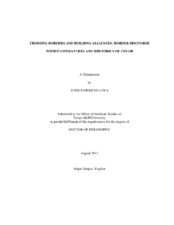| dc.description.abstract | Building on Victor Villanueva and Malea Powell's research in rhetoric and writing, in my dissertation I assert that the hierarchical construction of knowledges within literatures and rhetorics has traditionally been utilized to oppress the bodies, histories, and voices of color within both disciplines. I ask that we interrogate the ways in which divisions between communities of color have been rhetorically instated and use the space created by these rifts to build alliances and communities.
Centralizing my discourse within Indigenous and Chicana feminist practices, in Chapter I, I define rhetorical borders and illustrate how we can create alliances and provide the methodology for engaging the underlying rhetorics within interdisciplinary works. Practicing this methodology, in Chapter II, I utilize trickster rhetorics in my reading of Wendy Rose's The Halfbreed Chronicles to illustrate how an alliance between rhetorics and literatures facilitates an alternate reading to emerge that defies a colonial gaze and to illustrate how this methodology could be applied to other texts. In Chapter III, I juxtapose Leslie Marmon Silko's rhetorical storytelling structure exemplified in "A Geronimo Story" with Henry David Thoreau's "The Allegash and East Branch" to demonstrate how characters defy their hyperrealist constructions by enacting rhetorics of survivance to both protect people and knowledges and still have their stories heard. In Chapter IV, I argue that while initially the language barrier functions as a rhetorical border that defies history's colonial imposition in Tino Villanueva's Cronica de Mis Anos Peores, he ultimately utilizes it to both recover his childhood, memory and history, and also to create alliances with other native Spanish speakers whose own experiences will facilitate the understanding of the language used. In Chapter V, I argue that the pedagogical implications of bringing together works of literatures and rhetorics into the writing classroom will dramatically impact students' relationship to writing, storytelling, and meaning-making.
My dissertation contributes significantly to both disciplines of Rhetoric & Composition and Literatures of Color by redefining the tools and rules by which we can engage a text. Additionally, my dissertation demonstrates that only through mutual use of rhetorical and literary approaches, through an interdisciplinary alliance, can we truly hear all stories. | en |


